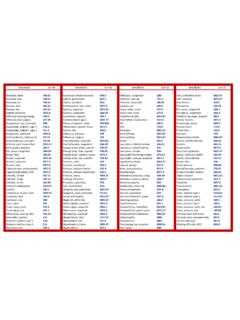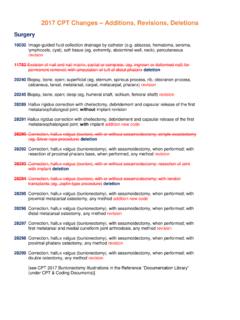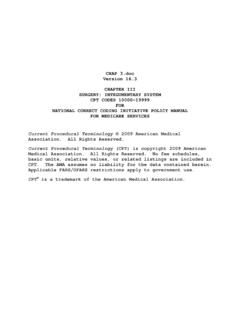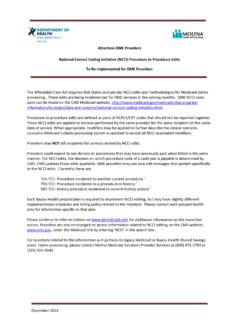Transcription of CHAP 8.doc CHAPTER VIII SURGERY: ENDOCRINE, …
1 CHAP Version CHAPTER VIII. SURGERY: ENDOCRINE, NERVOUS, EYE AND OCULAR ADNEXA, AND. AUDITORY SYSTEMS. CPT CODES 60000 - 69999. FOR. NATIONAL correct coding INITIATIVE POLICY MANUAL. FOR MEDICARE SERVICES. Current Procedural Terminology 2009 American Medical Association. All Rights Reserved. Current Procedural Terminology (CPT) is copyright 2009 American Medical Association. All Rights Reserved. No fee schedules, basic units, relative values, or related listings are included in CPT. The AMA assumes no liability for the data contained herein. Applicable FARS/DFARS restrictions apply to government use. CPT is a trademark of the American Medical Association. CHAPTER VIII. Surgery: Endocrine, Nervous, Eye and Ocular Adnexa, and Auditory Systems CPT Codes 60000 - 69999.
2 A. Introduction The principles of correct coding discussed in CHAPTER I apply to the CPT codes in the range 60000-69999. Several general guidelines are repeated in this CHAPTER . However, those general guidelines from CHAPTER I not discussed in this CHAPTER are nonetheless applicable. Physicians should report the HCPCS/CPT code that describes the procedure performed to the greatest specificity possible. A. HCPCS/CPT code should be reported only if all services described by the code are performed. A physician should not report multiple HCPCS/CPT codes if a single HCPCS/CPT code exists that describes the services. This type of unbundling is incorrect coding . HCPCS/CPT codes include all services usually performed as part of the procedure as a standard of medical/surgical practice.
3 A. physician should not separately report these services simply because HCPCS/CPT codes exist for them. Specific issues unique to this section of CPT are clarified in this CHAPTER . B. Evaluation and Management (E&M) Services Medicare Global Surgery Rules define the rules for reporting evaluation and management (E&M) services with procedures covered by these rules. This section summarizes some of the rules. All procedures on the Medicare Physician Fee Schedule are assigned a Global period of 000, 010, 090, XXX, YYY, or ZZZ. The global concept does not apply to XXX procedures. The global period for YYY procedures is defined by the Carrier (A/B MAC. processing practitioner service claims). All procedures with a global period of ZZZ are related to another procedure, and the applicable global period for the ZZZ code is determined by the related procedure.
4 Since NCCI edits are applied to same day services by the same provider to the same beneficiary, certain Global Surgery Rules Version VIII-1. are applicable to NCCI. An E&M service is separately reportable on the same date of service as a procedure with a global period of 000, 010, or 090 under limited circumstances. If a procedure has a global period of 090 days, it is defined as a major surgical procedure. If an E&M is performed on the same date of service as a major surgical procedure for the purpose of deciding whether to perform this surgical procedure, the E&M. service is separately reportable with modifier 57. Other E&M. services on the same date of service as a major surgical procedure are included in the global payment for the procedure and are not separately reportable.
5 NCCI does not contain edits based on this rule because Medicare Carriers (A/B MACs processing practitioner service claims) have separate edits. If a procedure has a global period of 000 or 010 days, it is defined as a minor surgical procedure. The decision to perform a minor surgical procedure is included in the payment for the minor surgical procedure and should not be reported separately as an E&M service. However, a significant and separately identifiable E&M service unrelated to the decision to perform the minor surgical procedure is separately reportable with modifier 25. The E&M service and minor surgical procedure do not require different diagnoses. If a minor surgical procedure is performed on a new patient, the same rules for reporting E&M services apply.
6 The fact that the patient is new to the provider is not sufficient alone to justify reporting an E&M service on the same date of service as a minor surgical procedure. NCCI does contain some edits based on these principles, but the Medicare Carriers (A/B MACs processing practitioner service claims) have separate edits. Neither the NCCI nor Carriers (A/B MACs processing practitioner service claims) have all possible edits based on these principles. Example: If a physician determines that a new patient with head trauma requires sutures, confirms the allergy and immunization status, obtains informed consent, and performs the repair, an E&M. service is not separately reportable. However, if the physician also performs a medically reasonable and necessary full neurological examination, an E&M service may be separately reportable.
7 Procedures with a global surgery indicator of XXX are not covered by these rules. Many of these XXX procedures are performed by physicians and have inherent pre-procedure, intra- procedure, and post-procedure work usually performed each time the procedure is completed. This work should never be reported Version VIII-2. as a separate E&M code. Other XXX procedures are not usually performed by a physician and have no physician work relative value units associated with them. A physician should never report a separate E&M code with these procedures for the supervision of others performing the procedure or for the interpretation of the procedure. With most XXX procedures, the physician may, however, perform a significant and separately identifiable E&M service on the same date of service which may be reported by appending modifier 25 to the E&M code.
8 This E&M service may be related to the same diagnosis necessitating performance of the XXX procedure but cannot include any work inherent in the XXX procedure, supervision of others performing the XXX procedure, or time for interpreting the result of the XXX procedure. Appending modifier 25 to a significant, separately identifiable E&M service when performed on the same date of service as an XXX procedure is correct coding . C. Nervous System 1. A burr hole is often necessary for intracranial surgery ( , craniotomy, craniectomy) to access intracranial contents, to alleviate pressure, or to place an intracranial pressure monitoring device. When this service is integral to the performance of other services, CPT codes describing this services are not separately reportable if performed at the same patient encounter.
9 A burr hole is separately reportable with another cranial procedure only if performed at a separate site unrelated to the other cranial procedure or at a separate patient encounter on the same date of service. In addition, taps, punctures, or burr holes accompanied by drainage procedures ( , hematoma, abscess, cyst, etc.). followed by other procedures are not separately reportable unless performed as staged procedures. Modifier 58 may be reported to indicate staged or planned services. Many intracranial procedures include bone grafts by CPT definition, and these grafts should not be reported separately. 2. Biopsies performed in the course of Central Nervous System (CNS) surgery should not be reported as separate procedures.
10 3. Craniotomies and craniectomies always include a general exploration of the accessible field. An exploratory craniectomy or craniotomy (CPT code 61304 or 61305) should not be reported separately with another craniectomy/craniotomy procedure performed at the same anatomic site and same patient encounter. Version VIII-3. 4. A craniotomy is performed through a skull defect resulting from reflection of a skull flap. Replacing the skull flap during the same procedure is an integral component of a craniotomy procedure and should not be reported separately utilizing the cranioplasty CPT codes 62140 and 62141. A. cranioplasty may be separately reportable with a craniotomy procedure if the cranioplasty is performed to replace a skull bone flap removed during a procedure at a prior patient encounter or if the cranioplasty is performed to repair a skull defect larger than that created by the bone flap.










